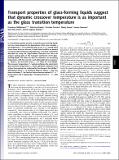Transport properties of glass-forming liquids suggest that dynamic crossover temperature is as important as the glass transition temperature
Author(s)
Mallamace, Francesco; Branca, Caterina; Corsaro, Carmelo; Leone, Nancy; Spooren, Jeroen; Chen, Sow-Hsin; Stanley, H. Eugene; ... Show more Show less
DownloadMallamace-2010-Transport properties of glass-forming liquids suggest that dynamic crossover temperature is as important as the glass transition temperature.pdf (968.2Kb)
PUBLISHER_POLICY
Publisher Policy
Article is made available in accordance with the publisher's policy and may be subject to US copyright law. Please refer to the publisher's site for terms of use.
Terms of use
Metadata
Show full item recordAbstract
It is becoming common practice to partition glass-forming liquids into two classes based on the dependence of the shear viscosity η on temperature T. In an Arrhenius plot, ln eta vs 1/T, a strong liquid shows linear behavior whereas a fragile liquid exhibits an upward curvature [super-Arrhenius (SA) behavior], a situation customarily described by using the Vogel–Fulcher–Tammann law. Here we analyze existing data of the transport coefficients of 84 glass-forming liquids. We show the data are consistent, on decreasing temperature, with the onset of a well-defined dynamical crossover eta×, where η× has the same value, eta× ≈ 103 Poise, for all 84 liquids. The crossover temperature, T×, located well above the calorimetric glass transition temperature Tg, marks significant variations in the system thermodynamics, evidenced by the change of the SA-like T dependence above T× to Arrhenius behavior below T×. We also show that below T× the familiar Stokes–Einstein relation D/T ∼ eta-1 breaks down and is replaced by a fractional form D/T ∼ eta-zeta, with zeta ≈ 0.85.
Date issued
2010-12Department
Massachusetts Institute of Technology. Department of Nuclear Science and EngineeringJournal
Proceedings of the National Academy of Sciences of the United States of America
Publisher
National Academy of Sciences (U.S.)
Citation
Mallamace, F. et al. “Transport Properties of Glass-forming Liquids Suggest That Dynamic Crossover Temperature Is as Important as the Glass Transition Temperature.” Proceedings of the National Academy of Sciences 107.52 (2010) : 22457-22462. ©2010 by the National Academy of Sciences.
Version: Final published version
ISSN
0027-8424
1091-6490